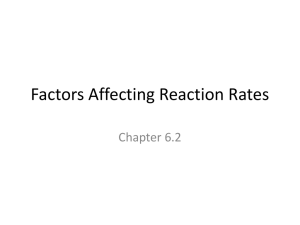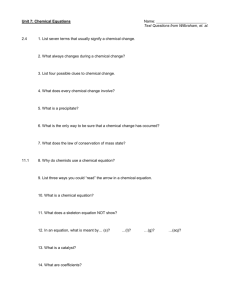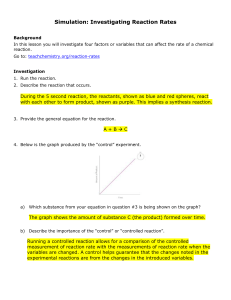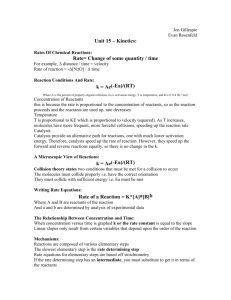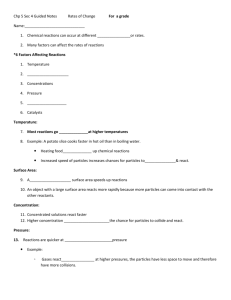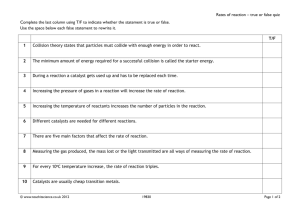Reactants à Products - Smithycroft Secondary School
advertisement
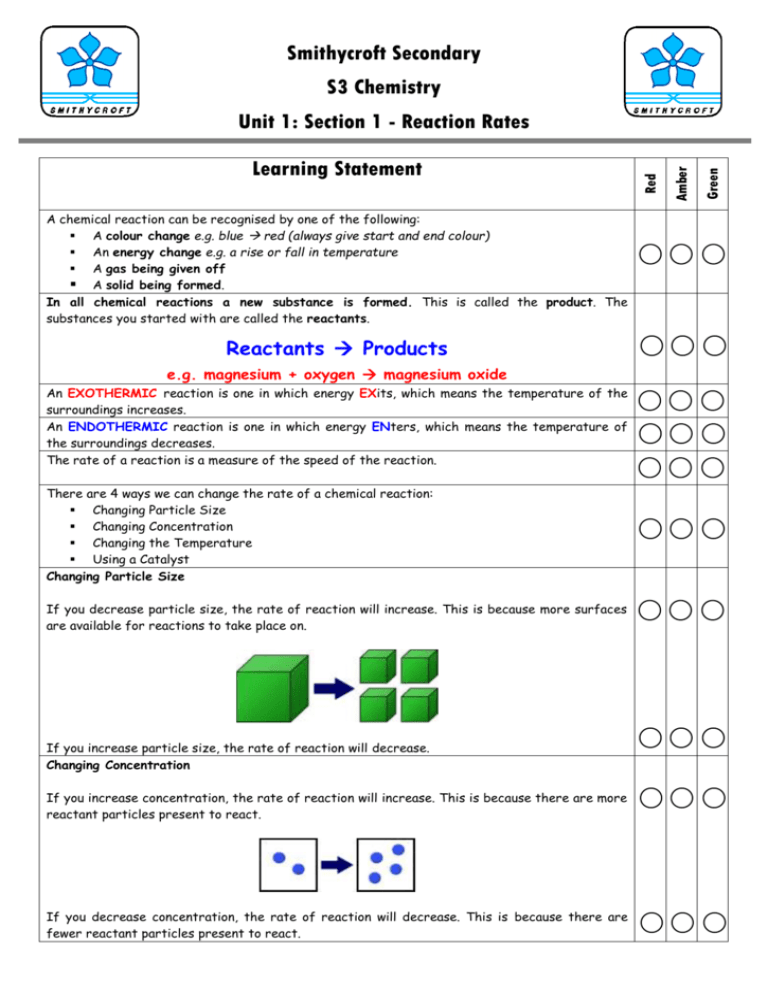
Smithycroft Secondary S3 Chemistry A chemical reaction can be recognised by one of the following: A colour change e.g. blue red (always give start and end colour) An energy change e.g. a rise or fall in temperature A gas being given off A solid being formed. In all chemical reactions a new substance is formed. This is called the product. The substances you started with are called the reactants. Reactants Products e.g. magnesium + oxygen magnesium oxide An EXOTHERMIC reaction is one in which energy EXits, which means the temperature of the surroundings increases. An ENDOTHERMIC reaction is one in which energy ENters, which means the temperature of the surroundings decreases. The rate of a reaction is a measure of the speed of the reaction. There are 4 ways we can change the rate of a chemical reaction: Changing Particle Size Changing Concentration Changing the Temperature Using a Catalyst Changing Particle Size If you decrease particle size, the rate of reaction will increase. This is because more surfaces are available for reactions to take place on. If you increase particle size, the rate of reaction will decrease. Changing Concentration If you increase concentration, the rate of reaction will increase. This is because there are more reactant particles present to react. If you decrease concentration, the rate of reaction will decrease. This is because there are fewer reactant particles present to react. Green Amber Learning Statement Red Unit 1: Section 1 - Reaction Rates Changing Temperature If you increase temperature, the rate of reaction will increase. This is because particles have gained more energy and are more likely to collide and react. If you decrease temperature, the rate of reaction will decrease. This is because particles have less energy and as a result are less likely to collide and react. Using a Catalyst In some reactions another chemical can be added to the reaction which will speed up the reaction. This chemical is called a catalyst. Catalysts do not get used up in the reaction so can be used again. For example if you put 2.73 g of catalyst into the reaction, you would be able to get 2.73 g of the catalyst back at the end of the reaction. e.g. Platinum is used as a catalyst in catalytic converters in car exhausts. Enzymes are biological catalysts.They catalyse reactions in living things. The rate of a reaction can be measured by monitoring the mass loss of reactants or the volume of gas produced in a reaction. Measuring Mass Loss of Reactants You could use the following apparatus to carry out this experiment. The reading on the balance decreases with time as a gas is being produced. Measuring Volume of Gas Produced You could use the following apparatus to carry out this experiment. Graphs can be plotted showing the change in mass or volume against time. This gives you curves with the following shapes. The steeper the line is, the faster the reaction is. The graphs level off eventually as the reactants are used up. 1. Mass of reactants or products against time 2. Volume of gas produced against time The results from a mass loss or volume of gas produced experiment can be used to calculate the average rate of reaction. Calculating Average Rate 𝐴𝑣𝑒𝑟𝑎𝑔𝑒 𝑅𝑎𝑡𝑒 = 𝐶ℎ𝑎𝑛𝑔𝑒 𝑖𝑛 𝑀𝑎𝑠𝑠 𝑜𝑟 𝑉𝑜𝑙𝑢𝑚𝑒 𝐶ℎ𝑎𝑛𝑔𝑒 𝑖𝑛 𝑇𝑖𝑚𝑒 Units of Average Rate 1. Mass and Time In this case rate is a measure of the mass loss over time therefore the unit of rate is g s-1 (grams per second). 2. Volume and Time In this case rate is a measure of the change in volume of gas over time therefore the unit of rate is cm3 s-1 (cubic centimetres per second).



